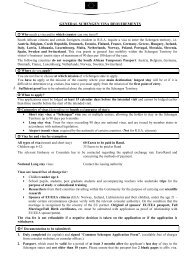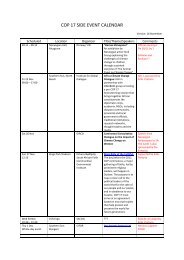Environmental impact management and planning: - Norway
Environmental impact management and planning: - Norway
Environmental impact management and planning: - Norway
Create successful ePaper yourself
Turn your PDF publications into a flip-book with our unique Google optimized e-Paper software.
Review of the Efficiency <strong>and</strong> Effectiveness (REE) of the South AfricanEIA systemPurpose: To review the successes <strong>and</strong> failures of EIA as a toolfor <strong>impact</strong> <strong>management</strong> <strong>and</strong> to identify alternative tools.OverviewThe new EIA regulations of 2006 (promulgated in termsof NEMA) were implemented on 3 July 2006. Given theexperience of almost 10 years of regulating EIA in SouthAfrica, the DEA decided to embark on a process to reviewthe efficiency <strong>and</strong> effectiveness of the EIA as a tool forenvironmental <strong>impact</strong> <strong>management</strong> in South Africa.The study had the following aims:• Review the efficiency <strong>and</strong> effectiveness of the EIAprocess as a tool for managing environmental <strong>impact</strong>sin terms of the NEMA EIA regulations.• Provide a retrospective view on the performance of EIAas a tool for EIM by considering:- Whether the EIA process achieves the intended goal.- Where goals were met, what were the critical successfactors <strong>and</strong> how can these be optimised.- Where goals were not met, what were the reasons forthis <strong>and</strong> how can it be rectified.- Whether the EIA, in terms of specific listed activities, isthe most appropriate tool for <strong>impact</strong> <strong>management</strong><strong>and</strong>, where it is not, to identify alternative tools.- To what extent the EIA tool contributed to meet thenational objectives <strong>and</strong> how effective <strong>and</strong> efficient it isin promoting benefits for the users (applicants, business<strong>and</strong> industry, non-governmental organisations, thepublic <strong>and</strong> authorities on national, provincial <strong>and</strong>municipal level).- The identification of key constraints <strong>and</strong> opportunitiesof the current EIA system <strong>and</strong> ways to improve thesystem.- Where EIA may be falling short in adding value tothe decision-making process.ProgressThe study followed a phased approach, which comprisedtwo main parallel parts:• Investigating the effectiveness <strong>and</strong> efficiency of EIAs byreviewing historic EIA processes against set criteria <strong>and</strong>comparing these to other processes.• Assessing the views of stakeholders involved in the EIAprocess.The study is completed <strong>and</strong> its outcomes have been madeavailable in a final closing report for the project. The outcomeshighlighted several problems <strong>and</strong> issues of concern, <strong>and</strong> anumber of recommendations have been made to addressthese. This process was followed by the 10 years of EIA inSouth Africa Conference in November 2008, where theexperience of the previous 10 years <strong>and</strong> the findings of thisreport were critically examined, <strong>and</strong> decisions were madeon the way forward.BenefitsIt was accordingly agreed by all stakeholders that they wouldparticipate in the formulation of the National <strong>Environmental</strong>Impact Assessment <strong>and</strong> Management Strategy (EIAMS). Thestakeholders also agreed on the process to be followed,the structures to be put in place, <strong>and</strong> the themes to beaddressed in the strategy. The findings of the REE form amajor part of this process.Possible further workThe REE has been concluded, but, as indicated above,it has been followed up by the EIAMS <strong>and</strong> there is scopefor international participation in this process. One of thestructures in this process is an advisory group, consisting ofinternational <strong>and</strong> local experts, who will provide comments<strong>and</strong> advice on documents <strong>and</strong> deliverables. Mr Terje Lind,Deputy Director-General of the NMoE, has been selectedto serve on this body. There is a need in this process for thefunding of specialist reports, workshops <strong>and</strong> the publicationof documentation.7







